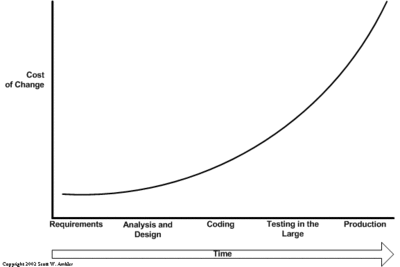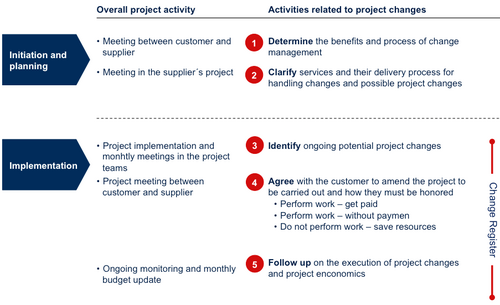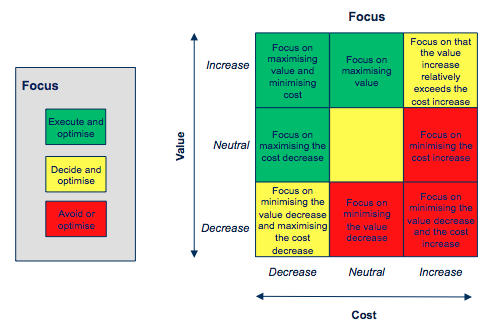Management of Project Change
| Line 15: | Line 15: | ||
= Process of project changes = | = Process of project changes = | ||
[[File:Process of the project changes.png|500px|thumb|right|Model 1. Process of project changes]] | [[File:Process of the project changes.png|500px|thumb|right|Model 1. Process of project changes]] | ||
| + | As mentioned earlier, there are many different ways to handle project changes. Each company has their own model for how the project change should be made. The whole process of project changes includes everything from meeting with the client and the identified project change to the final desicion and the monitoring and follow up on the project. Therefore, it will be descrived how and in which order the process change can be handled. | ||
The model is divided into two big phases that are: | The model is divided into two big phases that are: | ||
Revision as of 21:48, 21 September 2015
Management of project change is to handle changes in a company´s projects and is a very difficult thing master. The changes may occur because of new changes in the organization or maybe the customers has requested a change in the product or a new service. Project changes occur in all industries such as the electronic industry, the entertainment industry, the textile industry and so on in almost all kinds of companies . An example of a project change could be a supplier that are building an administration building for a customer and six months in the process the customer suddenly also want a underground parking. Now the supplier has to change the project so the additional cost can be minimized and the project still can be built on time. To handle such changes require experience and good planning.
In this article, the following topics will be described to give the reader a better understanding of how project changes can be handled in the following order:
- Cost of project changes
- Process of project changes
- Project change decision process
- Negotiation of project change
- Conclusion
Contents |
Cost of changes
Changes in projects appear almost in all businesses and in all kind of companies. To avoid increased costs, it is important to analyze and deal with possible project changes early in a project. If the project team does not have a clear plan on how changes are handled, the changes can be implemented too late or not being implemented at all which can result in increased cost of the change write[1]. On figure 1 it is shown how cost of change grows over time. The graph shows that the cost of change is on the y axis and time is on the x axis. If changes occur in the process because the project team are aware of the changes and know how to handle it in early stage the cost will be reduced and time too. And that´s why it´s important that project changes are handled efficiently and quickly so that the changes not will result in additional costs than expected.
Process of project changes
As mentioned earlier, there are many different ways to handle project changes. Each company has their own model for how the project change should be made. The whole process of project changes includes everything from meeting with the client and the identified project change to the final desicion and the monitoring and follow up on the project. Therefore, it will be descrived how and in which order the process change can be handled.
The model is divided into two big phases that are:
- Initiation and planning
- Implementation.
The initiation phase will begin before the start of project to ensure that the expectations of potential project changes are aligned with the customer and supplier. The initation phase has two overall activities there are marked in the two red circles with a 1 and 2.
1) In the first activity there will be a meeting with the customer and the supplier. In this activity it is very important that the benefits and process of change management will be determined. One of the biggest mistakes in projects is when expectations are not attuned to possible future changes in a project. When there is consensus and clarity of the possible future project change, the project group meeting will find place in the second activity.
2) In the second activity the supplier has now determined the benefits and process of change management with the client. Therefore the company will have a meeting with the project team to clarify services, delivery process and possible project changest that adresses the customers need that was determined in activity one.
When activity one and two are completed, then phase two can be startet.
The implementation phase will begin when the project starts and in this phase potential project changes will be identify and afterwards the customer will make the final desicion on the change to be made. Finally, there will be continuous follow up on the project. The initation phase has three overall activities there are marked in the three red circles with a 3, 4 and 5.
3) In the third activity the ongoing potential project changes will be identified and there will be monhtly meetings in the project teams. As the project goes ahead there will continually be possible project changes and these will be discused in the project teams. To have an overview of all the posible project changes a change register will be used as seen on figure 1. All the information about the different types of changes will be listed in the change register and be used on the meetings and for the customer.
4) In the four activity there will be a meeting between the customer and the supplier where the potential project changes will be showed to the client. Here it will be assessed if the project changes has to be implemented or not. It can be very diffucult to choose between the different types of potential project changes and therefore the desicion making about a project change will be detailed described in the section xxx.
5) In the five the activity there will be follow up on the execution of the project changes and its economics and estimation of time. Furtheremore there will be monitoring and monthly budget updates thus that the estimated time and cost will be met.
Project change decision process
As mentioned earlier, it can difficult to choose between which project changes that should be made. Often is there a tight deadline and therefore it is not necessarily all project changest that can be performed. Therefore it is important to choose the most important project changes. The model to handle the decision proces can be seen at picture 2[2].
The model is divided into three phases that are:
- Project changes
- Value for money (value and cost)
- Effect
The Project changes phase In the first phase it must be assessed what the possible project change we should consider to implement is and why we should implement it.
The value for money (value and cost) phase In the second phase it must be assessed what value the change will bring and what it will cost and how the focus should be to ensure maximum value for money for the change. Figure 2 shows a matrix where the value can be seen at the y-axis and the cost been seen at the x-axis. The purpose of the matrix is to decide what changes that are most important seen from a value and cost point of view. The best place to be in the matrix is in the green box in the upper left corner where the value will be increased and the cost will be decreased. The place we not would be is in the red box in the lower right corner where the value will be decreased and the cost will be increased.
The effect phase In the third phase it must be assesed what the effect of the change is and if it does deliver added value in relation to the project objectives for the stakeholders. The effects has to create value for the project and therefore it is positive thing if the project change contains most multiple effects as possible. The project change should result in an effect that benefits the project. Furthermore it is positive if the project change are affecting more stakeholders in a good way than before the change of the project.
Different types of effect and stakeholders that a project change can effect can be seen below.
Effect (e.g.)
• Time
• Quality
• Future proofing
• Sustainability
• Brand and image
• Health and Safety
• Etc.
Stakeholders (e.g.)
• The Client
• The Clients’ clients
• Users
• Authorities
• Suppliers
• Society
• Shareholder and investors
• Etc.
Negotiation of project changes
When the proposed project changes are completed, then they have to be disclosed to the client and then be negotiated. Early discussion and warning of project changes to customers gives a greater negotiationg space and opportunities for both sides. This can for example minimize the cost as mentioned in the change and cost curve at picture 1. There are different negotiation processes and below is an example of a negotiation process[3] that consicts 6 phases in the follow order:
- 1) What is the project change?
- 2) What are the suppliers and the customers alternatives?
- 3) What are the suppliers and the customers interests?
- 4) Negotiation variable
- 5) Prioritizing of each negotiation variable
- 6) Plan dialogue and engotiation
1)In this phase the type of the project change must be identified and investigate what the contract says. This makes it easier to negotiate with the customer. Furthermore it will be a good idea to identifying relevant stakeholders and how they best will be affected. It will make it more attractive for the customer to make the project change if the project change will make the final result better for the present stakeholders. Or if the project change will result in new stakeholders.
2)In this phase it is important to clear what alternatives the supplier have and what alternatives the customers have. If the customer has few or no alternatives then the customer will could make a better deal with the customer compared to if the customer has many alternatives.
3) In this phase it must be clarified what interests that the customer and the supplier have. Interests must be understood as what the underlying causes of the positions. Then it can be possible for the customer to find underlying and hidding interests which will make it more easy to understand the customer and thereby create a better negotiation.
4) In this phase the supplier must identify and consider possible negotiation variables. This means everything that can be negotiated in negotiating process. Example of negotiation varibles can be economics elements, contractual conditions, laws by the governments, clauses and so. By knowing all these different variables an upcoming negotiation will possibly end up with a better outcome.
5) In this phase will all the negotiation from the previous phase be prioritized. This will result in a more focused discussion and negotiation process. The prioritizing can be made with points going from 1 to 100 where 1 is low and 100 is high.
6) In this phase the final dialogue and engotiation with the supplier will be planned before the final meeting. Here is it very important that all the information and decisions from the five earlier phases are finished and ready for the future engonation. Furtheremore it will be a good idea to define a starting point, target and pain threshold for each negotiation variable. Finally the supplier must consider the sitiation from the customers point of view. This avoids that the supplier end up negotiating with it self. At least the supplier must consider the reaction of the supplier and what types of scenarios that may arise when the negotiations have begun.
Conclusion
Mastering project changes is very diffucult because of the different types of projects and types of customers. Since the project change is very complex is there not a certain way to deal with it but many different. The methods in this article are made based on many years of experience. As mentioned earlier it is important not to underestimate the handling of project changes because project are often more costly to change the longer the project gets. Furthermore a professional handling of project changes will improve the companys competiviness and that is way project change is change is so important to be able to control.
References
- ↑ http://www.agilemodeling.com/essays/costOfChange.htm#Figure1
- ↑ Process of project changes, Figure, Sveko
- ↑ Process of project changes, Figure, Sveko
http://www.agilemodeling.com/essays/costOfChange.htm http://www.wisegeek.com/what-is-product-change-management.htm http://www.computerweekly.com/opinion/Five-tips-for-managing-project-change-requests http://www.dummies.com/how-to/content/how-to-manage-project-change-requests.html http://cobaltpm.com/effective-project-change-management http://4pm.com/change-requests-4pm-com


